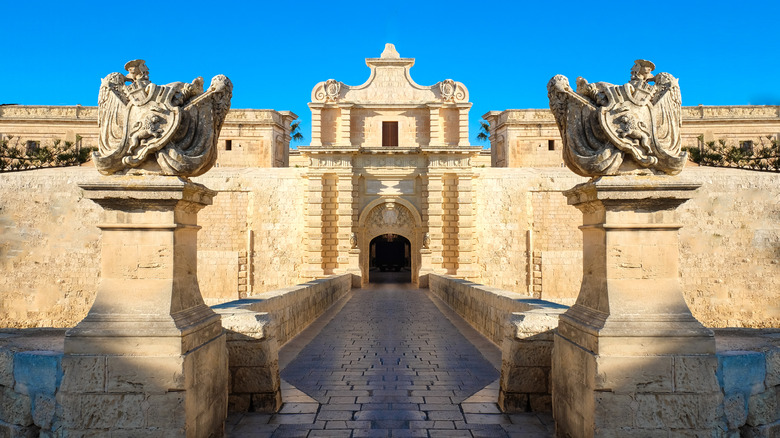Jericho is one of the oldest cities in the world, a historic place that’s had a continuous human presence since the third millennium BC. Its age is mind-boggling, but no mention of Jericho is complete without describing its once-massive walls, which kept the city safe from invaders. “The walls of Jericho represent the earliest technology uncovered by archaeologists that can be ascribed unequivocally to purely military purposes,” states Britannica.
One could argue that the defining feature of any human settlement is a protective barrier against animals and unwelcome guests. To this day, we see this inclination in our cities, towns, and villages, where people erect fences to cordon off their own space and keep their homes safe. Though the modern world has no real use for walled cities, fortunately, some are still standing, and there’s never been a better time to see them in all their splendor. Let’s take a look at the most gorgeous walled cities around the world.
Dubrovnik, Croatia
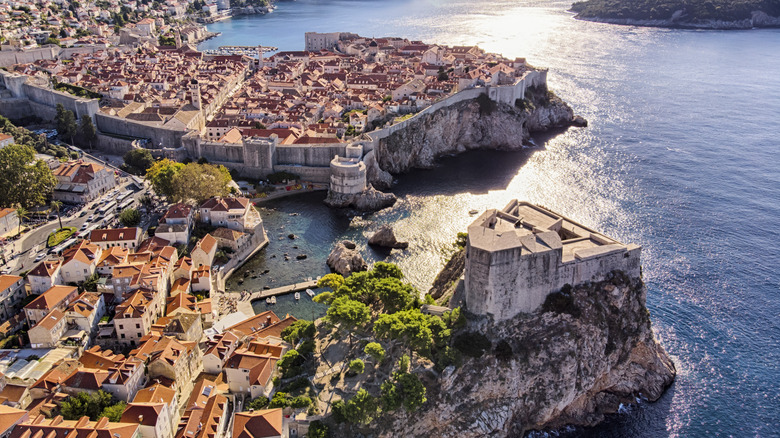
Upon first setting foot in Dubrovnik, you might think, “Hey, this place has a ‘Game of Thrones’ vibe,” and you’d be right: Dubrovnik was used as King’s Landing in the hit HBO fantasy. Its sprawling red roofs, tight city passages, and unspoiled Mediterranean backdrop pull you back in time to an age of adventure. The so-called Pearl of the Adriatic offers way more than just “Game of Thrones” tours, however.
Dubrovnik’s impressive walls are as old as the city itself. It was founded as Ragusa in the 7th century and initially functioned as a refuge for coastal peoples fleeing barbarians before becoming an important trade location. The Dalmatian coast was part of a key trading route at the time, allowing Dubrovnik to compete with the famed Venice for a slice of the commerce. As a result, the defensive walls became even more important, and they are still a marvel to this day.
Thankfully, the city walls are open to the public. You don’t need to buy a ticket in advance, but if you would rather secure one before you arrive, then you can do so via the Society of Friends of Dubrovnik Antiquities. On top of getting an intimate view into the past, you’ll be supporting a good cause: The money helps the Society of Friends of Dubrovnik Antiquities maintain the walls for future generations to enjoy.
Jerusalem, Israel
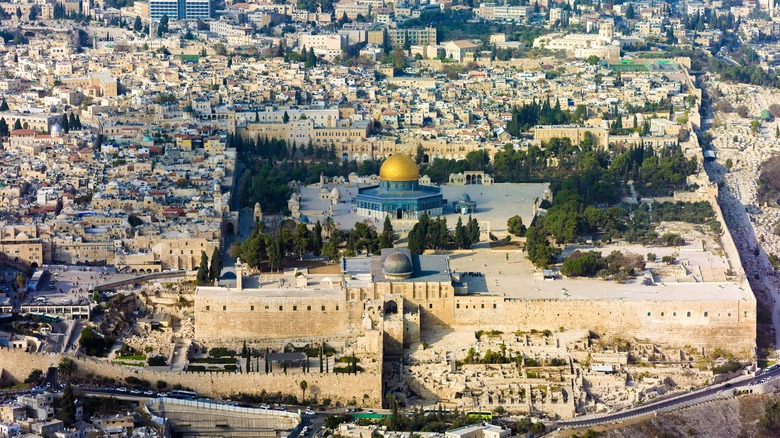
No list of walled cities would be complete without mentioning Jerusalem. Like Jericho, Jerusalem is one of the oldest continually inhabited places in the world and is steeped in history. “Archaeological work in the area suggests that the city was inhabited as far back as 4000 BC,” Al Jazeera reports. Jerusalem is home to several monuments of religious significance, such as the Dome of the Rock, the Western Wall, and the Holy Sepulchre. The city’s walls have a history all of their own, as they’ve been raised up and torn down many, many times.
Jerusalem hasn’t always been so big — in fact, it was just ten acres when King David conquered it in about 1,004 BCE. Solomon, Hezekiah, and Nehemiah all expanded its borders and built early walls. The Roman Titus came in and tore them down, and the cycle repeated until about 1537, when the final iteration of the walls — the ones we see today — were built by Suliman the Magnificent. The walls of Jerusalem are easily accessible for visitors, with guided tours along the ramparts. Certain segments, such as the Western Wall, are open all day, every day.
Tallinn, Estonia
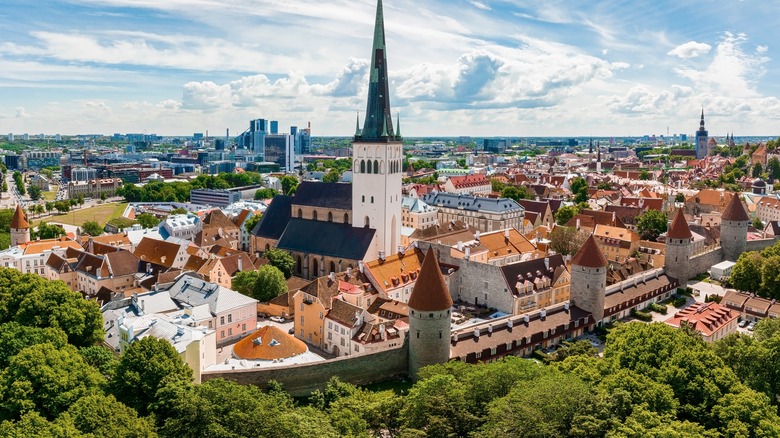
Pandora Pictures/Shutterstock
Estonia is one of those lesser-known European destinations that doesn’t get as much credit as it deserves. This former Soviet country has a wonderful capital city in Tallinn, a charming place with an old town steeped in history. Around the edge of the old town is about a mile’s worth of wall that’s been standing since the 13th century. Estonian authorities have gone to great lengths to restore and maintain the squat walls and red-roofed towers. There are so many different sections, towers, and gates that some require their own ticket, such as the Kiek in de Kök tower.
You can walk along the ramparts and squeeze through the tight spiral staircases like a medieval soldier. Inside the walls, you really feel like you’ve been transported back in time. The cobbled, winding streets take you past old stone shops, the town hall square, and a black-tipped cathedral. If you like, you can even spend the night in one of the local hostels. The old town is divided into a lower and upper section, with Toompea Hill offering excellent views over the area and the rest of Tallinn. Everything is within walking distance here, so bring some comfy shoes if you decide to visit.
Lo Manthang, Nepal

Jasper Neupane/Shutterstock
Nepal brings to mind remote mountaintop temples surrounded by colorful bunting streamers and spinning prayer wheels. It’s a small Himalayan country that requires a Jeep — and tolerance to elevation changes — to be seen in all its glory. Nestled high up in the foothills at about 12,000 feet sits the spectacular Lo Manthang. It dates back to 1380, when Nepal as it is known today was several different kingdoms. Lo Manthang was once a trade route stop for merchants passing through the Himalayas and shares a great deal with neighboring Tibet in terms of culture and history.
Given how difficult it would be to import stone and other building materials, Lo Manthang is made out of mud bricks. It’s a small town, home to less than a thousand people, so it’s easy to walk the perimeter in a single day. That said, traveling here isn’t cheap. Lo Manthang is located in Upper Mustang, which requires a restricted area permit. This costs $500 a day for your first 10 days, then an additional $50 per day after that, and that’s on top of what you’ll pay an authorized trekking company to reach it. However, if you want to visit a walled settlement that isn’t overrun with tourists, it’s worth the price and the effort.
Chiang Mai, Thailand
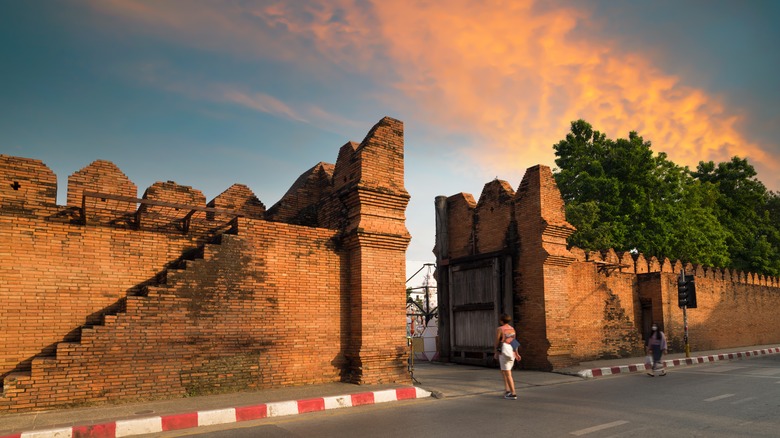
Daphnusia Images/Shutterstock
One of the best places to visit in Thailand, Chiang Mai is a trendy northern city full of ancient temples and great eateries. Over the years it has become very popular with backpackers and vacationers alike, and it’s easy to see why. Founded in 1292, this intoxicating city was once the capital of the Lanna Kingdom. It was invaded by forces from nearby Myanmar in 1558 and subsequently came under their rule, though Taksin, the king of Siam (modern day Thailand), took it from them in 1774. Chiang Mai became a walled city in the 18th century, and much of the walls still exist to this day, standing alongside a moat that runs around the edge of the beautiful old town.
The Tha Phae Gate, which is at the eastern entrance of the old town, is particularly impressive. The square just outside the gate is used for celebrations and is the place to be during Yi Peng (a three-day celebration in which locals and tourists alike set off sky lanterns) and Songkran (the Thai New Year celebration famed for being a huge, nationwide water fight — don’t venture out with electronics, because you will get soaked). Chiang Mai is also a coffee lover’s paradise, with cafes galore, and a great place for excursions: It’s essentially the foothills of the Himalayas, and Mount Inthanon — the highest point in Thailand — can be reached by car with relative ease.
Aït Benhaddou, Morocco
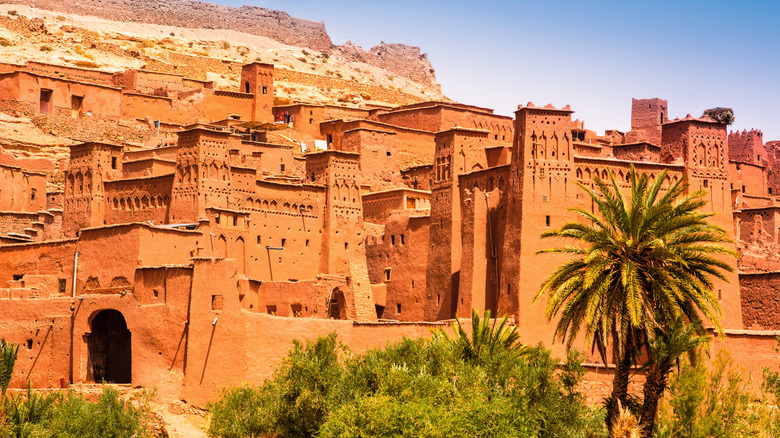
Elena Studio/Getty Images
Morocco is a spellbinding North African country with a beautiful capital in Marrakesh. The city’s historic medina is surrounded by some impressive walls, but if you really want to see the best of Morocco’s walled settlements, you’ll need to leave the capital and head toward Aït Benhaddou. This “ksar” (a local word for fortress) is built out of a material called adobe, which is a mixture of straw and mud. It’s perfect for harsh desert climates, as it maintains a comfortable inside temperature during scorching days and frigid nights.
Aït Benhaddou consists of six fortresses (each built by a different family) combined into one, with walls designed to protect its inhabitants from the perils of the desert, particularly raiding enemy tribes. The adobe here features ornate, complex designs, from its tower tops to the arches on its gates. Aït Benhaddou will make you re-evaluate your assumptions about how detailed a building made out of mudbricks can be, it’s that stunning.
The fortress complex also includes Berber architectural innovations such as “kasbahs,” cliff citadels that merge into the topography so well that they’re difficult to spot from a distance by enemies. Film buffs may recognize the place as a setting in classic flicks like “Lawrence of Arabia” and “Gladiator.” It’s still inhabited, too, albeit by a small group of people. A stroll inside the walls will take you by artisanal shops, a mosque, and tons of winding alleyways that make you feel like an extra in a movie.
Seoul, South Korea
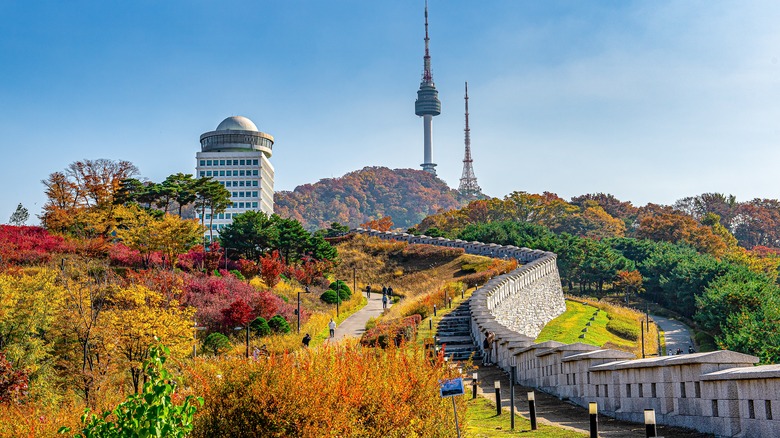
Onruecha Wasan/Shutterstock
Even if you’re not into K-pop and K-dramas, Seoul should still be on your bucket list. This massive South Korean city features oodles of ancient palaces, unparalleled river bicycle paths, and more Korean barbecue than you could ever hope to eat. But one thing most tourists aren’t aware of is that Seoul was once a walled city — and segments of it still remain. The Seoul City Wall, or “Hanyangdoseong,” stretches 18.6 kilometers and once served to protect the Joseon dynasty.
Seeing the entirety of the Hanyangdoseong is quite the task, one that takes several days to complete. Unless you’re going to be in Seoul for a few weeks, it’s best to pick and choose which lengths you wish to see. Some parts are short and sweet, such as the Sungnyemun and Heunginjimun sections, each less than 2 kilometers with only a minimal climb. Others are full-fledged hikes that snake up into the mountains, such as Baegak — consider packing hiking boots if you want to do this part.
Whichever segment you decide to tackle, you’ll have a blast. It’s almost like a scavenger hunt that takes you through old city gates, Hanok villages, marketplaces, and palaces. The city has grown up around the walls in such a way that you’ll often spot them by accident when stepping off the subway or bus. Most are 100% free to visit, too, which is always a bonus.
Intramuros Manila, the Philippines
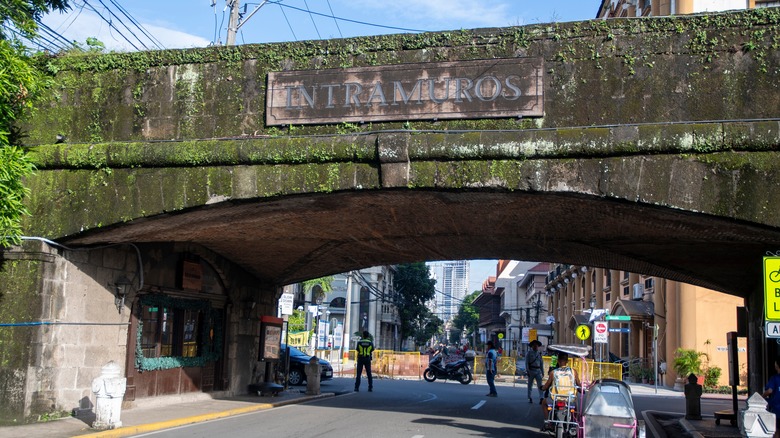
Tang Yan Song/Shutterstock
It’s common for tourists to remain in Manila only long enough to grab their next flight to some beautiful beach. Perhaps people are spooked by all the traffic and sprawl; Manila is one of the most densely populated cities in the world. But if you leave too soon then you’ll be missing out on Manila’s many malls, museums, Chinatowns, parks, and — you guessed it — the remnants of a city wall.
Manila’s walled city district is known as Intramuros, Spanish for “between the walls.” The Spanish established their first settlement in the Philippines in 1565 and founded Manila six years later. Intramuros has been in place since then and was once an enclosure strictly for the elite, housing the Governor’s Palace and Manila Cathedral. The six-meter-tall wall included a moat for repelling attacks from Spain’s many enemies — namely neighboring Chinese and other imperial forces such as the Dutch and the Portuguese.
Following the Philippine Revolution and the subsequent American occupation, the Japanese briefly conquered the island nation during WWII. Intramuros was subsequently subjected to Allied bombing and, sadly, large parts of the walls were destroyed. These days, you’ll find short, moss-covered lengths of it surrounded by old Spanish architecture, providing a small — but beautiful — window into the Philippines’ Spanish past. You can wander them yourself or book onto a guided tour.
Ávila, Spain
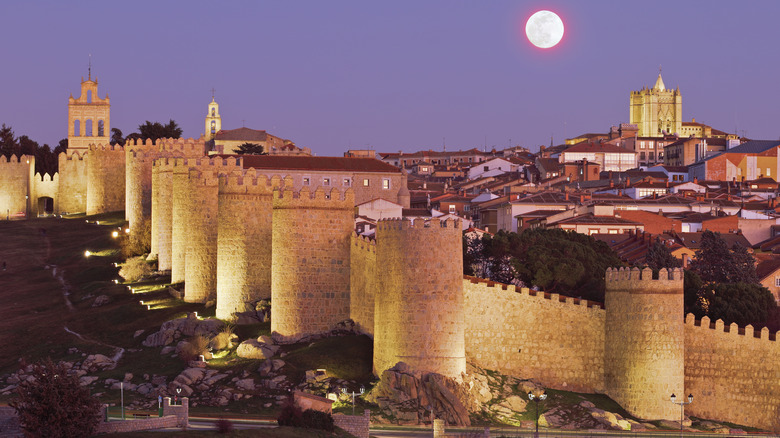
S. Greg Panosian/Getty Images
Ávila, Spain, is a living reminder of Spain’s fascinating past. The Southern European country was invaded by the Moors in the 8th century, a conquering force from North Africa that took a great swath of the Iberian Peninsula. If not for key battles like Charles Martel’s victory near Poitiers and several hundred years of Reconquista (Spanish for Reconquest), Spain might be a very different place today. Ávila is special in this regard because it once sat in the “no man’s land” between warring powers, a common site of battle any time conflict arose. Naturally, city dwellers wouldn’t have survived in such brutal times without one thing: tall, strong walls.
A UNESCO World Heritage Site, Ávila sets itself apart from most walled cities as its walls are remarkably intact: All 2.5 kilometers of this architectural masterpiece are still standing strong to this day. Some say that Ávila is the best example of a walled city anywhere in Europe, and it’s hard to argue against them. Whether you’re an avid historian or just an average traveler, Ávila will take your breath away — it really does look like something out of a fairytale. Visitors have two options: Walk around the perimeter, or buy a ticket to hike the two different sections of ramparts. The city’s quite accessible for visitors, too (it’s about an hour and a half from Madrid by car).
Mdina, Malta
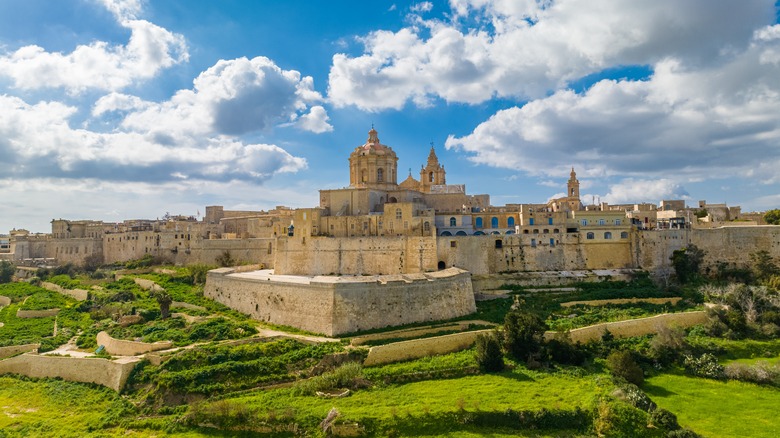
Karina Movsesyan/Shutterstock
Malta is a tiny Mediterranean island that often gets skipped over for other nearby destinations because people assume that it’s not worth a visit. Nothing could be further from the truth. Malta takes only an hour to drive across but treats you to a treasure trove of historical and cultural sites reflecting the island’s ever-changing history in the clash between Mediterranean superpowers. It’s got lots of claims to fame, such as being the place where the shipwrecked Apostle Paul allegedly recovered and an Allied holdout against the onslaught of invading Axis powers during WWII. If you decide to take a trip to Malta, then you can’t miss the walled city of Mdina.
Mdina was at one point Malta’s capital, situated in a prime defensive position up on a hill. It was built with bastions — a type of triangular, jutting-out fortification ideal for cannon and musket warfare. In keeping with the times, only a limited number of vehicles are permitted entry into this small city — hence the “Silent City” moniker used by the local Maltese. So, prepare to break out your walking shoes. The architecture here ranges from medieval Norman to the much later Baroque period, seen in the churches, cathedrals, homes, and even dungeons you can visit. Of course, you can also traverse segments of the walls themselves on a Mdina walking tour.
Cartagena, Colombia
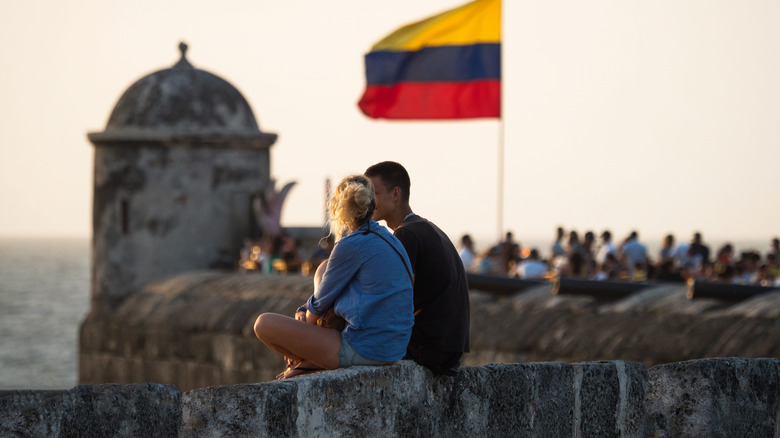
Maphke/Shutterstock
Sir Francis Drake was an English privateer credited with circumnavigating the globe in addition to sinking countless Spanish ships and plundering his way across the Americas in the name of the crown — he was dubbed by his colleagues as a “fearful man to the king of Spain.” He forced one of the greatest navies the world has ever seen to readapt and reevaluate. Drake is known to have plundered one Spanish colony in modern-day Colombia — Cartagena — so badly that King Philip III himself sanctioned a set of protective walls. They were the brainchild of the Italian architect Carlos de Roda Antonelli, who came up with a design that was able to withstand the barrage of cannon fire with low, thick bastions.
The build occurred in installments, taking approximately two centuries to complete. Piracy was rampant in this age, so the walls were going up even as attacks were bearing down on them. It’s rumored that the infamous Henry Morgan ran his operations out of Providencia, an island off Colombia’s coast. Cartagena’s walls were ingenious, utilizing breakwaters and underwater caissons to deny entry to enemy ships, becoming a key Spanish fortress in the process. Though the age of piracy is over, the 11 kilometers of cordon wall in Cartagena remain for you to visit yourself.
Quebec, Canada
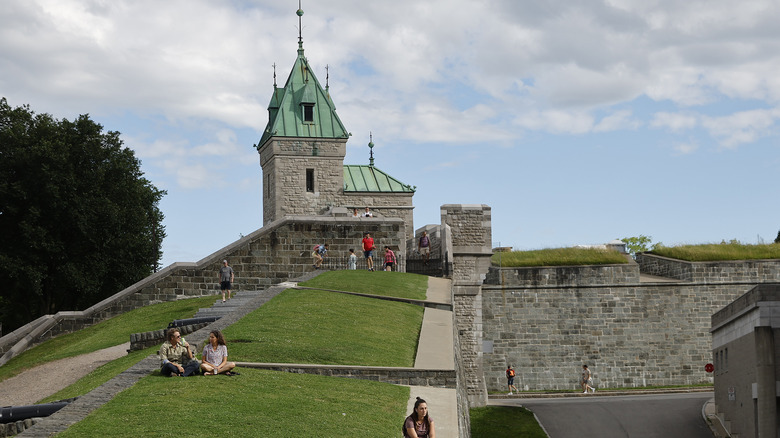
Chip Somodevilla/Getty Images
All the aforementioned locations on this list are at least a layover away, so are there any options closer to home? The United States is too young for castles and fortifications, but our northern neighbor has the only fortified city you’ll find on this side of the Americas: Quebec. It’s one of Canada’s oldest cities, beginning as a trading post for the then-lucrative fur trade. It then transformed into a more permanent base and a key strategic location in the wars between the French, the British, and the fledgling United States, thanks to its rocky escarpment.
Quebec entrenched itself in a series of walls over the years. Work on the final iteration, which was designed by Gaspard-Joseph Chaussegros de Léry (Louis XV’s Chief Engineer in New France), began in 1745. Inside the walls, you’ll find the old Château Frontenac Hotel, the wooden Dufferin Terrace boardwalk, America’s only Holy Door at the Notre-Dame de Québec Basilica, and a toboggan slide for the bravest among you. Canadian authorities have gone to painstaking lengths to preserve the old city and walls exactly as they were. For example, they put every stone back exactly where it originally was after injecting new grout.

